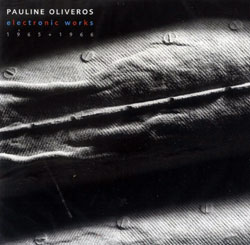
Oliveros's pioneering electronic music from the mid-60s, when she held court at the San Francisco Tape Music Center alongside fellow provocateurs Ramon Sender and Morton Subotnick, has not only aged like fine French wine, its contours, approaches, textures, and striations eclipses anything today's bedroom boffins can remotely hope to dream up. Of course, unlike those software-happy mouseketeers, Oliveros realized her sonic bric-a-brac the old-fashioned way, equal parts knob-twiddling, tape splicing, and patch-cord insertion, all festooned with an experimental discipline wrenched from endless hours spent at machines coated in literal and intellectual sweat.
These three works represent a culmination for Oliveros of sorts. Still hip-deep in the Burroughs-ian cut-up methodologies that had animated whole segments of the musique concrete contingent, it's nigh on amazing (and a testament to Oliveros' sheer breadth of creative will) that these livid, oozing, tactile sounds can feel just as utterly breathtaking now as they must have 40 years ago. Even more impressive is that the works from this era are quite musical, unlike the general schematics adopted by the academic experimentalists of the time (Subotnick included) who were content to realize virtual yards of disjointed and often unlistenable bleep and bloop. Not so Oliveros: she had a knack for erecting tautologies within electronic sound whose opposite poles worked off each other quite pragmatically, hardly ever descending into abject noodling simply for noodling sake. The opening 25 minute "I of IV" is a case in point, a boisterous exercise in aural chromatics that begins with pulses of jangly distortion before settling into a not-too-comfortable zone populated by sounds of quite interstellar, neé alien, design. In fact, roughly halfway through the piece, one would be forgiven for thinking Oliveros was unconsciously channeling Louis and Bebe Barron's classic score for Forbidden Planet, often using similar call-and-response tonalities that whoop about like inimical life forms volleying across four dimensions. It's all brilliant stuff, taking the listener places only glimpsed in dreams, the artist grounding such flights of fancy thanks to the pliant nature of electricity and her ability to mold it accordingly.
The remaining pieces work similar skeins of magic. "Big Mother Is Watching You" takes the art of "noise" into somewhat more inhospitable realms, Oliveros slicing up her soundscapes with billowing winds, ticking clocks, and strange, snapping "percussions", a veritable teeming weather system that is at turns ominous and disturbing. The closing "Bye Bye Butterfly" also reveals microcosmic worlds within worlds, burned atmospheres colliding with fast-spinning particles and a definite, faux-"rhythmic" sense of motion that is over far too soon. Oliveros remains a true original, one who needs broader reassessment to properly (and fairly) gauge her remarkable influence across electronic music's often parochial bandwidth.
Comments and Feedback:
|



